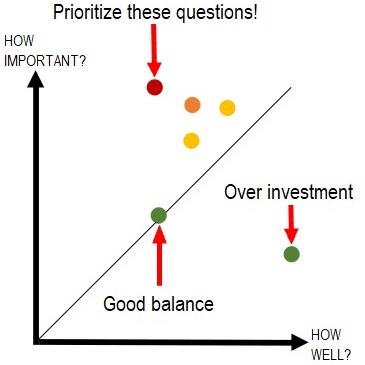Unique method
Our unique method of analysis, Gap method, measure questions from three dimensions:
- Expectations - How important is the question?
- Experiences - How well is the question is being met?
- Potential - How large is the gap between “how important” and “how well”?
The size of the gap shows how much potential for improvement a question has.

The Key Strengths of the GAP Method
The Gap Method is supported by a wide range of international academic and applied research. The key strengths of the GAP method are:
- In-depth and Reality-based Insights
The GAP method offers a more comprehensive and realistic analysis by not only identifying the challenges but also understanding why they exist and how they impact the organization. This provides a deeper understanding of the underlying issues. - Actionable Insights for Sustainable Improvements
The method delivers insights that can be immediately translated into action, helping organizations not only understand what needs to be addressed but also how to implement these actions to achieve long-term and sustainable improvements. - Increased Employee Engagement through Involvement
The GAP method focuses on creating real and meaningful improvements based on both customer and employee perspectives. When employees feel they can influence the organization’s development, it often leads to increased engagement and a stronger sense of involvement. - Higher Quality and Precision in Results
The method is better suited to reflect the organization's actual conditions, which means the results are more accurate and useful. This ensures a higher quality of decision-making data. - Clear Communication and Understanding
One of the GAP method’s major strengths is its ability to deliver insights in a clear and easily understandable way, allowing both employees and customers to readily grasp the information.
